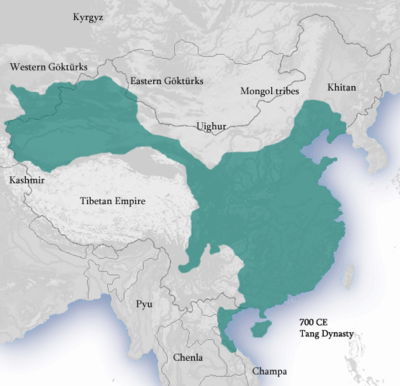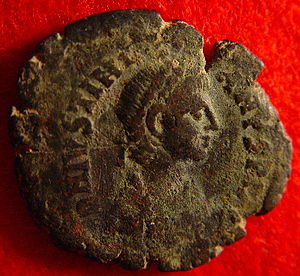New course 1.1
Jump to navigation
Jump to search
Developments in East Asia from c. 1200 to c. 1450
Empires and states in Afro-Eurasia and the Americas demonstrated continuity, innovation, and diversity in the 13th century. This included the Song Dynasty of China, which utilized traditional methods of Confucianism and an imperial bureaucracy to maintain and justify its rule.
Continuities and Innovations in China
- During the classical age, the Han Dynasty found that a bureaucracy of merit made of Confucian scholars was more conducive to running a centralized state than relying on local aristocrats to implement imperial rule. In the post classical age the Tang Dynasty reinstated this tradition of using a Confucian bureaucracy in China's political system. The Confucian civil service exams were brought back, and candidates studied Confucian classics with the hope of meriting an esteemed post in the Chinese government. One effect of reestablishing the civil service bureaucracy was that the cultural content of Confucianism continued to influence Chinese civilizations. For example, patriarchy continued to be a feature of Chinese society during the Tang Dynasty and traditional social hierarchies were reinforced.
- The Tang did not simply copy the accomplishments of the Han. Onto these borrowed traditions they grafted their own innovations. One such innovation resulted from the Tang's attempt to address a problem that crippled the Han during the last centuries of its rule: the unequal distribution of land across society. The Tang developed the equal field system to prevent peasant land from falling into the hands of the aristocracy, which happens so often during hard economic times. In this system, the government owned all the land but periodically redistributed it to families according to their need. This provided for a fairer distribution of land and a more equitable method of taxation (although the basis for calculating the tax was an issue of intense debate during the Tang.) [1]
- During the classical age, the Han Dynasty found that a bureaucracy of merit made of Confucian scholars was more conducive to running a centralized state than relying on local aristocrats to implement imperial rule. In the post classical age the Tang Dynasty reinstated this tradition of using a Confucian bureaucracy in China's political system. The Confucian civil service exams were brought back, and candidates studied Confucian classics with the hope of meriting an esteemed post in the Chinese government. One effect of reestablishing the civil service bureaucracy was that the cultural content of Confucianism continued to influence Chinese civilizations. For example, patriarchy continued to be a feature of Chinese society during the Tang Dynasty and traditional social hierarchies were reinforced.
- Another innovation of the Tang Dynasty was its policy of establishing tributary states. Although earlier Chinese dynasties collected tribute, the practice became more complex and standardized under the Tang. The Chinese tributary system was based on their belief that Chinese civilization was superior to others, but barbarian and non-Chinese people could have access to Chinese ways providing they ceremonially recognized the supremacy of China and paid tribute to the emperor. [2] Thus China could "radiate" its superior civilization to barbarian people around it. In reality, the tributary system was a means for China to control conquered lands that often proved difficult to rule. Chinese dynasties had long tried to project their control over the Korean peninsula; indeed, its long costly war with Korea did much to discredit the Sui Dynasty, the Tang's predecessor. The Tang Dynasty gave its support the the Silla family of Korea to ensure their rule over the entire Korean peninsula, but it cost the Silla their independence. The price China demanded for helping the Silla was that they become a tributary state of the Tang emperor. Each year representatives from Korea traveled to the Chinese capital to purchase their rule with payments of tribute. They returned with Chinese customs, fads, Buddhist writings, clothing fashions, and literature. Through this tributary relationship much Chinese influence made its way into Korea.[3]
- In summary, the recovery of Chinese civilization in the post classical era was made possible by building on classical traditions, such as the Confucian civil service bureaucracy, and fusing them with new administrative practices such as the equal field system and the creation of tributary states.
- THE BYZANTINE EMPIRE
- The Byzantine Empire thought of itself as the continuation of Roman civilization, so it was only natural that it would continue and build upon the foundations of classical Rome. One of Rome's most enduring legacies was its system of law. Indeed, even the barbarians who brought down the western half of the empire in the 5th century adopted the system of Roman law to regulate their civilizations. In the surviving eastern half of the Roman Empire the task to update laws and make them relevant to the new situation of Byzantine civilization fell to the emperor Justinian. Although he technically lived before the post classical age (482-565 CE) his code of laws profoundly influenced the Byzantine empire and constitute the greatest example of the Byzantine Empire building on a tradition of Rome.
- As the classical age drew to a close, many of the previous Roman laws were rendered obsolete by changing conditions of the empire. Confusing and contradictory laws hindered the functioning of courts. Moreover, Roman civil law often conflicted with the eastern empire's adopted religion of Christianity.[4] In response to this situation, Justinian commissioned the formation of several bodies of law which are collectively referred to as the Code of Justinian.
- Like classical Roman Law, the Code of Justinian gave order and security to a collection of diverse peoples across the breadth of the empire. It punished dishonest tax collectors and encouraged honest trade. "Rape was punished by death and confiscation of property, and the proceeds were given to the injured woman." [5] What was entirely new about the Code was its enactment of Christianity morality into Roman civil law. It enforced the Church's views on divorce, adultery and homosexuality, and the Church's property was protected as a permanent holding. Death, torture and mutilation were common punishments. The Code of Justinian was an innovation but one built upon one of Rome's most successful traditions: law.
- Another of the Byzantine Empire's innovations was prompted by a pressing security issue: the advance of Islam on its eastern frontier. Protecting its borders against barbarian incursions was a significant problem for the late Roman Empire, but Islam represented a much more organized front. To counter this threat the Byzantine Empire developed a system of imperial organization called the theme system. Each theme, or province, was placed under the leadership of a general who organized its administration and defense. Each general was responsible directly to the emperor and he recruited his armies from the free peasants. In return for military service, the peasants were given land. The theme system provided incentives for increased grain production and gave the empire effective and loyal soldiers. Under this system the empire protected its eastern borders and captured additional land in Anatolia and present day Syria.[6]
- Unlike most of the era of Western Rome, the Byzantine Empire had an official religion, Orthodox Christianity. To adapt to this circumstance the Empire developed a new model of authority. Beginning with Constantine and extending to the end of the empire, they operated under an ideology called Caesaropapism, the vesting of political and religious authority under a single figure. Thus the emperor, the political head of state, simultaneously acted as the head of the organized Church. Again, Byzantine civilization innovated to meet the circumstances of the empire's realities.
- Another innovation of the Tang Dynasty was its policy of establishing tributary states. Although earlier Chinese dynasties collected tribute, the practice became more complex and standardized under the Tang. The Chinese tributary system was based on their belief that Chinese civilization was superior to others, but barbarian and non-Chinese people could have access to Chinese ways providing they ceremonially recognized the supremacy of China and paid tribute to the emperor. [2] Thus China could "radiate" its superior civilization to barbarian people around it. In reality, the tributary system was a means for China to control conquered lands that often proved difficult to rule. Chinese dynasties had long tried to project their control over the Korean peninsula; indeed, its long costly war with Korea did much to discredit the Sui Dynasty, the Tang's predecessor. The Tang Dynasty gave its support the the Silla family of Korea to ensure their rule over the entire Korean peninsula, but it cost the Silla their independence. The price China demanded for helping the Silla was that they become a tributary state of the Tang emperor. Each year representatives from Korea traveled to the Chinese capital to purchase their rule with payments of tribute. They returned with Chinese customs, fads, Buddhist writings, clothing fashions, and literature. Through this tributary relationship much Chinese influence made its way into Korea.[3]
- ↑ http://afe.easia.columbia.edu/ps/cup/tang_tax_debate.pdf
- ↑ The Ways of the World: A Global History., (2009), Robert W. Strayer, p. 249.
- ↑ Pre-Modern East Asia: A Cultural, Social, and Political History, Vol 1. (2012) Patricia Buckley Ebrey, p. 108.
- ↑ The Age of Faith. (1950) Will Durant, p. 111.
- ↑ Durant, p. 113.
- ↑ Traditions and Encounters. (2006, 3rd ed.) Jerry Bentley et al., pp. 323-4.


